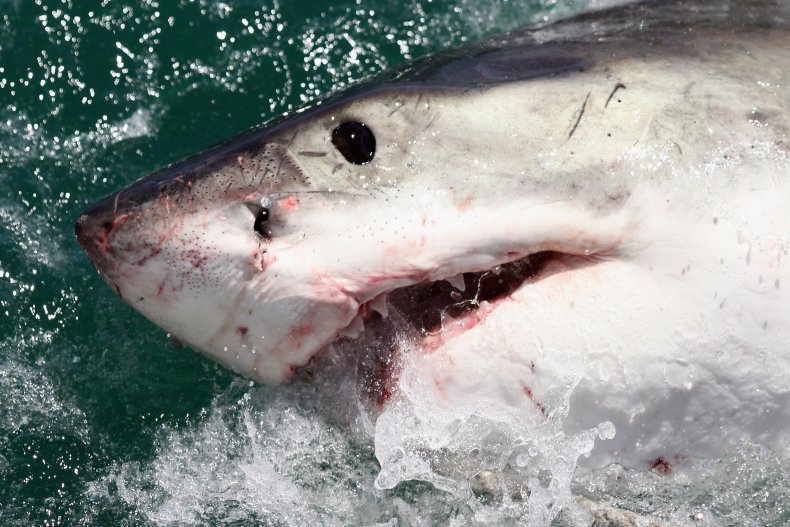Killer whales that attacked great whites off the coast of South Africa removed some of the sharks’ livers, hearts and testes, autopsies have revealed.
A scientist who helped perform post-mortems on six sharks that washed up on the shores of Gansbaai, about two hours from Cape Town, described how they had been “physically ripped open” by the whales in a “precise and refined” way.
Marine biologist Alison Towner said the whales, which are also known as orcas, tore the majority of the sharks’ skins just below the throat in order to create a cavity from which the liver—weighing up to 180 lbs—would slide out.
Great white sharks generally, she said, are not known for washing up dead after attacks and rarely become available for scientific study.
Newsweek subscription offers >
“It was really just shock and disbelief when we heard there’s another large, virtually adult white shark on the beach with its liver ripped out,” she told YouTube channel Shark Talk, hosted by Gemma Care, recently.
The first shark Towner and colleagues examined still had its liver, but it was covered with razor marks. “It was the day after two killer whales had come through and no one at that point was willing to make the call that it was possibly orca,” she said.
They called in shark expert Malcolm Smale to consult on the next case they had and he soon made the link with the killer whales, which was later confirmed by an orca expert in New Zealand.
Newsweek subscription offers >
Towner said the autopsies on the great whites took hours to perform, with the team meticulously taking measurements from each part of the shark. “Then in we go to establish if there are any signs of trauma that meant you could discount orca predation,” she told Care. “Any boat injuries, fishing lines…trauma that could’ve been the cause of death.
“When the animal is lying there with its 60 kilo liver ripped out, it’s pretty obvious.”
Towner said that she has no background in killer whales, so had to do a lot of reading and speak to experts on the species. “It’s clear to see that wherever they are in the world they’ve learned hunting strategies that are so precise and refined…and taught to their young,” she said.
There have been a number of reports of killer whales attacking sharks off the South African coast since 2017. Initially, scientists reported the discovery of deceased sevengill sharks washing up with their livers removed. However, other species—including great whites—were also targeted.
Researchers eventually linked the attacks to two killer whales that had been seen in the area. It is thought the killer whales removed their livers as this is a hugely nutritious organ.
‘Testes removed’
“These injuries on the great whites were identical to those on the sevengills in false bay in that the animals were physically ripped open.” Towner explained.
“Just under the surface of the skin is the perfect place to open up the shark and access and extract the liver,” Towner said. “I think two of the animals had both the heart removed and one male had his testes removed. Because they’re very close there in the body cavity.
“We think the two killer whales were learning to get hold of the pectoral fins. We don’t know for sure. It’s like a ripping motion. The liver… it’s oily, very slippery, it would naturally slide out so they could come along and share it.”
Initially, reports connected the arrival of the killer whales off the coast of South Africa to great whites vanishing from areas where they normally gather in large numbers, such as False Bay.
Previous research from a marine sanctuary off the coast of San Francisco, where great whites and killer whales both frequent, suggested the latter would leave the area if orca were present. However, in South Africa it is thought many factors—including overfishing—have contributed to their mystery disappearance.
Mary Rowlinson, marine biologist and manager at the Shark and Marine Research Institute, previously told Newsweek that a number of human practices, including overfishing and pollution, were behind the decline seen in the region.
Talking about the fall in numbers overall, she said: “Our white sharks are one population around South Africa. You do not have a separate population at each site. So it is very important that whilst the most notable declines have been observed in False Bay, our whole white shark population around our entire coastline is declining in numbers and is threatened with extinction.”



















